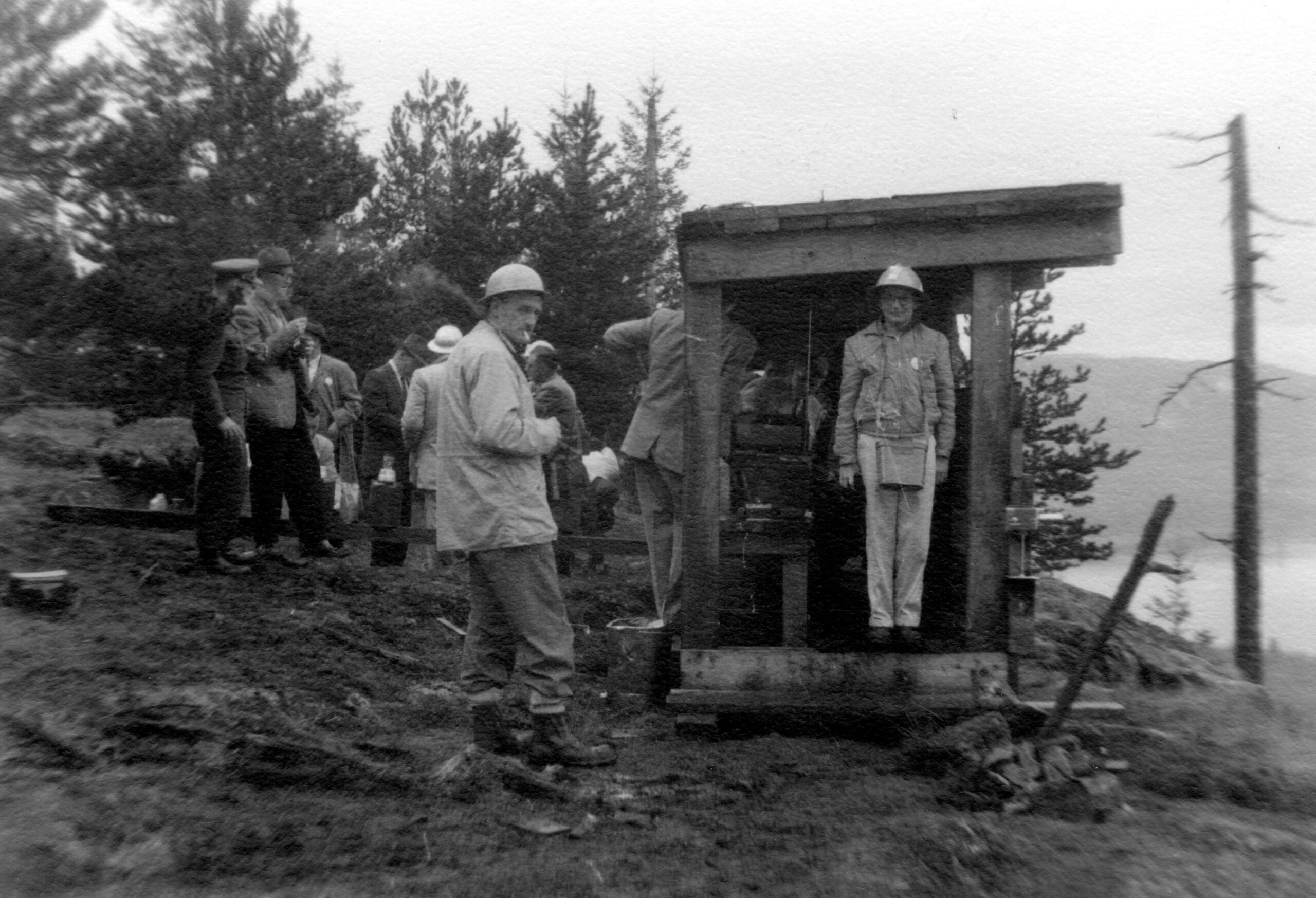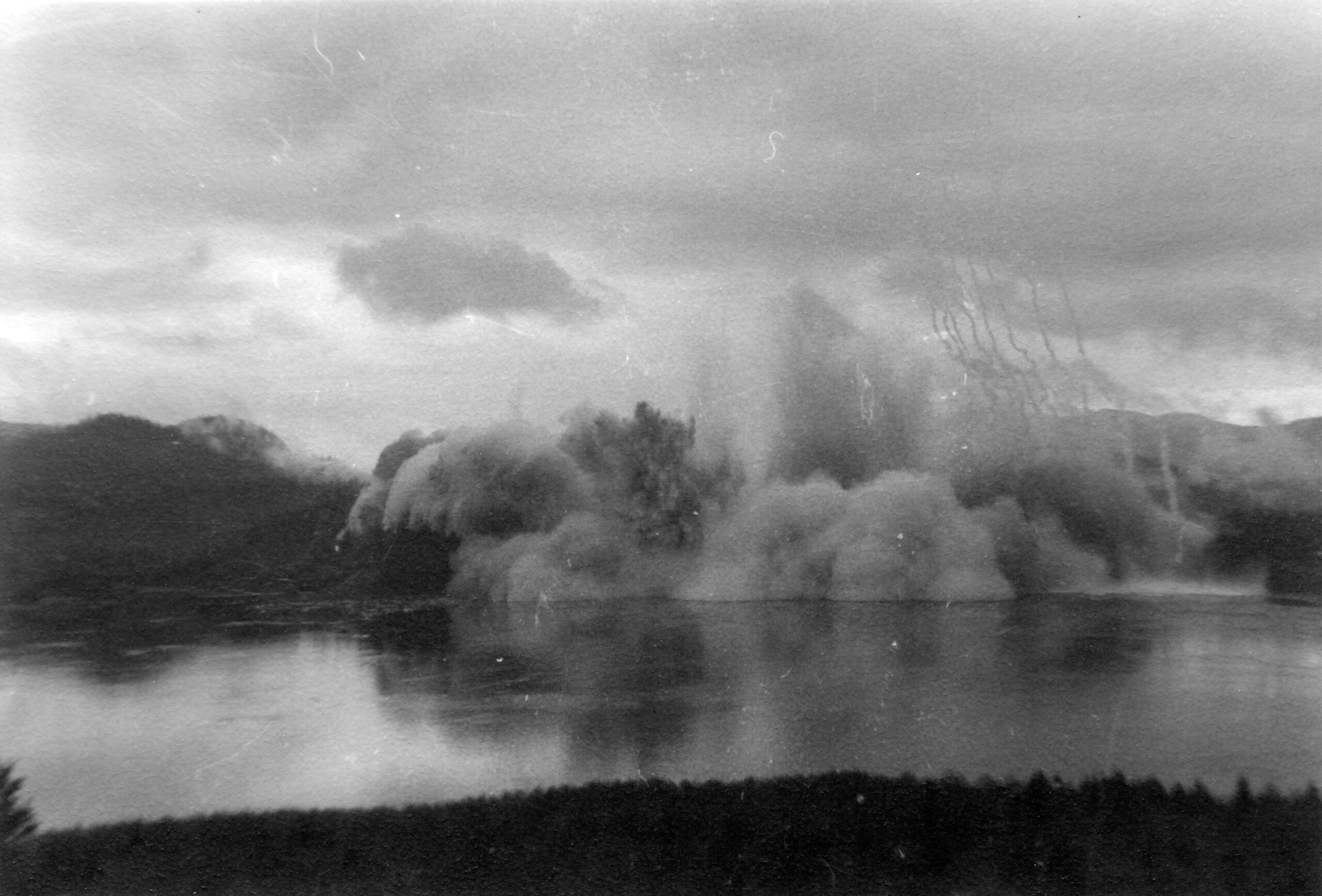It was 9:30 a.m. when geological engineer Victor Dolmage entered a squat bunker overlooking Seymour Narrows and laid his finger on the button.
Nearby, a cohort of helmeted, khaki-clad engineers nervously made their final preparations. Crowded into another nearby bunker were 75 reporters from media outlets across the country, including CBC, Life , and the Vancouver Sun. Though every angle had been figured, the team still prepared for the worst. All nonessential personnel within a radius had been evacuated, including the nearby towns of and . In Campbell River, uniformed nurses stood vigil in the streets, alongside 10 ambulances on standby. The skies were grey, but the heavy cloud cover experts feared hadn’t materialized, meaning that, after four years of work and half a century of debate, it was time.
At exactly 9:31 a.m., Dolmage pressed the button.
What followed is considered one of the largest non-nuclear explosions in history, an engineering marvel that required thousands of tons of explosives and many kilometres of underground tunnels. It would be viewed coast to coast and become the subject of songs and documentaries, even being designated a National Historic Event. It was April 5, 1958, and the dreaded Ripple Rock—the province’s deadliest navigational hazard—was finally no more.
“In that brief moment or two, our bunker shook and you sensed, more than heard, a deep penetrating rumble,” the Times Colonist reported. “Then the waters opened up. The whole of the narrows erupted in breath-taking, dreadful beauty. This was the death of Ripple Rock at the hands of man.”
Located in Seymour Narrows, near Campbell River, the underwater mountain known as Ripple Rock had claimed more than 100 lives, dozens of ships, and cost millions in damage throughout the 19th and 20th centuries. “Old Rip” (as it was known by mariners) occupied the middle of an already perilous body of water, rife with deadly currents, whirlpools, and rapidly changing tides. The first European to recognize it was Captain George Vancouver, who called the surrounding area “one of the vilest stretches of water in the world” in his 1791 logbook.
“In the centre of the Narrows the water churned and foamed around the deadly ‘Ripple Rock,’” a Sun journalist added in June 1923. “A whirling vortex against which no steering gear could respond, circled madly around the submerged rock. With unconquerable strength it sucked all that came within its sphere to a terrible destruction. We watched a great log, fully four feet in diameter and forty feet long, being gradually drawn into its seething clutches.”
The rock first made international headlines in 1875, after destroying the American navy steamer Saranac. By then, Seymour Narrows was already a crucial waterway for U.S. ships heading to Alaska via the inside passage, but the constant danger of Old Rip led to serious international friction. After several more shipwrecks in the early 1900s, Americans began loudly demanding its removal—with Canadians footing the bill.
“The howl from Puget Sound comes as a result of the United States cableship Burnside striking the rock a week ago to-day and tearing a large hole in her bottom,” The Province wrote in November 1904. “Canadian navigators,” the authors added smugly, “are so well aware of the location of the rock that they give it a wide berth.”

Personnel in a bunker position on an area hilltop before the blasting of Ripple Rock. Image courtesy of the Sherwood and Evelyn Lett family fonds, City of Vancouver Archives.
There is little evidence the demand from our southern neighbours was ever taken seriously. Over the next 15 years, half a dozen more large ships (and countless smaller ones) were destroyed on Ripple Rock: Spokane in 1911, Cottage City in 1912, Henry Villard in 1916, and Princess Ena in 1919. The first real discussion of Old Rip’s removal began in 1920, after Skeena MP Cyrus Wesley Peck sent a petition to Ottawa, supported by various shipping interests. Sustained pressure from the industry led to several government surveys, and in the summer of 1928, Ottawa agreed to appropriate funds for a removal project.
There was one major problem, though. They had no idea how to do it.
“The means of getting at the rock to carry out its removal from the racing waters is the puzzle on which engineers are working,” read a dispatch from Ottawa in June 1928, “but departmental heads state that the rock will be tackled if it is physically possible to get to it.”
The effort quickly stalled, and in the wake of continuing public discussion, something curious happened: a vocal movement sprang up, arguing to save Ripple Rock. Throughout 1929 and 1930, Victoria newspapers were besieged with angry letters to the editor urging to keep the rock in place—though their missives often lacked any basis in fact.
“Neither the Saranac nor any other steamer was lost due to Ripple Rock,” one letter claimed, falsely, in the March 11, 1930, issue of Victoria’s Times Colonist. “No lives were lost on the rock and no great material loss. During the rush to the Klondike more steamers passed through Seymour Narrows than will again for many years without any loss of any consequence”
The protest peaked during a March 1930 meeting at Victoria City Hall, where 300 people argued against Ripple Rock’s removal. Loudest among them was Robert Towne Williams, a Victoria city councillor and bookbinder, who championed building a network of bridges between the islands. That there was no money and no feasible plan to do so didn’t appear to bother him. When government officials met in Victoria the following January to continue discussions, he and his cohort redoubled their efforts, descending on the meeting en masse to again protest the project. By this point, officials had already had enough.
“If the citizens of Vancouver Island succeed in defeating the honest efforts of seamen to make navigation safer,” one official said to the crowd, “they will succeed in making themselves ridiculous.”
After systematically dismantling the protestors’ arguments, officials announced, to their dismay, that plans to survey and blast had already been authorized. But it wouldn’t be until 1942 that resources became available. The initial plan—to anchor a drilling barge to the rock with steel cables—was an unmitigated disaster. Powerful currents snapped the cables, on average, every 48 hours. In 1945, engineers tried again, but after sinking a million dollars into the effort, they were again forced to walk away.
It took another 10 years before a suitable approach could be found. In January 1955, a contract was awarded to two Vancouver firms to carry out a novel plan: avoiding the narrows by drilling beneath the rock itself and planting explosives in a network of overlapping underground tunnels. The firms—Northern Construction Co. & J.W. Stewart Ltd., and Boyles Bros. Drilling Co.—estimated it would take two years, and despite its complexity, the work proceeded smoothly. Three teams, working around the clock, advanced downward at the rate of approximately six feet per day. Even so, by January 1957, they were well behind schedule. During this period, the Ripple Rock resistance made one final appearance, though they were largely viewed as a nuisance by locals: a petition circulated the week before the blast only attracted 100 signatures. By fall 1957, engineers were testing the explosives, working to avoid undue disruption of marine life by firing low-intensity depth charges in advance of the real blast. But most important, they could finally set a date for Old Rip‘s demise: April 5, 1958.

Aerial view of Ripple Rock prior to blasting of Seymour Narrows. Image courtesy of the Major Matthews collected photographs collection, City of Vancouver Archives.
By the time Victor Dolmage approached the detonator on that overcast morning, all eyes were on Ripple Rock. In addition to the Life reporters and the gaggle of local journalists, radio and video simulcasts were set up to capture the event on live television. Buses brought eager tourists to a designated viewing area nearby. In Victoria, Humber’s department store had an “explosion sale” touting “Ripple Rock Bottom Prices.” When Dolmage pressed the button at 9:31 a.m., 700,000 tons of rock were shot into the air—some up to 300 metres high—and history was made. Despite the team’s concerns, the blast made little impact outside of Seymour Narrows—even in nearby Campbell River, barely a window rattled.
Today, navigation remains challenging, but Seymour Narrows has become popular with kayakers, whale watchers, and cruise ships bound for Alaska. Old Rip is long gone, and the only indicator of the explosion that removed it—the result of decades of planning and local ingenuity—is a small plaque overlooking the narrows. But perhaps its most fitting eulogy was published in the pages of The Province in January 1955, before the explosion even took place, courtesy of an amateur poet named Alan Greig:
A million years I’ve faced the tide
In all its force and fury,
And stood my ground, a famous rock
To countless judge and jury.
But now it seems I am condemned
And guilty at the bar,
A verdict which I don’t deny;
A menace near and far!
Salute to thee, O captains all!
Ahoy! My flag is high,
As yonder bit of blasted rock
I am about to die.
Read more local history stories.









